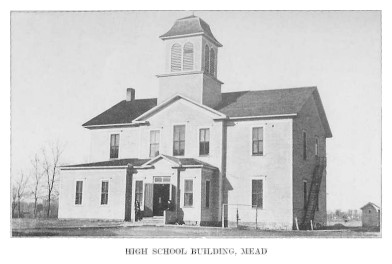
High School Building, Mead

Street Scene in Mead
CHAPTER X
SAUNDERS COUNTY TOWNS
MEAD
The Town of Mead is located in section 35 of Marietta Precinct, on the Union Pacific halfway between Wahoo and Yutan. The population is composed of a progressive and energetic type of people, mostly Swedish, but with a sprinkling of other nationalities.
The names of Condit, Ostenburg, Knowles, Hall, Sturdevant, Mills and Becker are associated with the beginning of this town. C. T. Condit, now cashier of the Bank of Mead, constructed the first house in the town in the year 1877. This is the house in which he now lives, although it has been remodeled and enlarged. Mr. Ostenburg assisted in the building of this home. These two men started in the lumber and grain business in Mead in the same year and put up the scales in the snow when there was little or nothing in sight.
Charles Ostenburg started a grocery store in the new town in 1877 and it is still standing on the main street. This was just one year after the railroad came through. The second store in Mead was opened for business by W. N. Becker. Charles Ostenburg erected the second residence. Joseph B. Sturdevant was the first depot agent.
A frame school building was erected in 1886 and is still used. The first lawyer in the town was Freeman Knowles and the first physician was Doctor Hall. E. F. Mills was another early comer. It is established that Joseph Sturdevant was already living in the country near Mead when Condit came in 1877; the former was keeping bachelor's hall in the little depot and Ostenburg and Condit boarded with him.
123
124 PAST AND PRESENT OF SAUNDERS COUNTY
C. W. Wilson opened up the first drug store in Mead; then John Ohmstead started a general store, in a frame now the M. W. A. hall. John Jepson also entered the drug business. The first newspaper enterprise in the town was the publication of the Advocate by W. N. Becker. This paper is now published at the office of the Visitor in Valparaiso and can be noted in the history of that paper.
The Bank of Mead was started as a private bank in 1885 with C. T. Condit, president; Thomas Austenburg and Henry Anderson, vice presidents; and P. L. Hall, cashier. The capital stock was $5,000, which has grown in the meantime to the sum of $15,000. The institution was incorporated as the Bank of Mead on December 31, 1900. P. L. Hall is now president of the bank; C. T. Condit is cashier; Thomas Austenburg is vice president and G. Soderberg is assistant cashier. The bank carries a surplus of $5,000 and the deposits average about $240,000.
A water and electric plant was established in Mead in 1914 and is a distinct advantage to the residents of the town. The service on the Union Pacific is well adapted to the business of the merchants, a point which they have taken to, advantage and in no town of the size in the county can there be found a better class of merchandise of every kind than in Mead.
MALMO
In section 15, Mariposa Precinct, is situated the Town of Malmo, a small, but industrious and important town of Saunders County. This town is located on the Schuyler branch of the Burlington Railroad, with two trains each day.
Malmo had its beginning in 1886, at which time the town was surveyed on land purchased from Jerry Fisher. The names of Ostenburg, Bredenburg, Hulsing, Bostrom, Bruce, Blomberg, Rosenberg, Nelson, Larson, Ljungstrom, Olson, Frostrum, Hokanson, Erickson, Eliason and Pherson are prominent among the early settlers of Malmo and vicinity. L. Isaacson was the first to settle anywhere near the site of Malmo. He was from Kristianstad Lan, Sweden, having emigrated to this country in 1868 and settled and homesteaded in the spring of the next year. Andrew Blomberg came two weeks later from Omaha with a
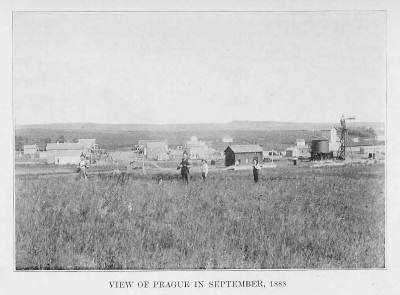
View of Prague in September, 1888
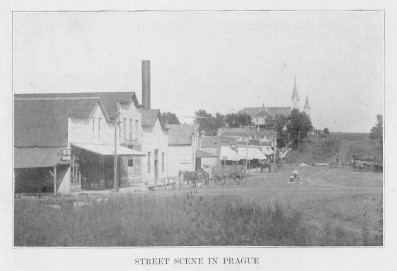
Street Scene in Prague
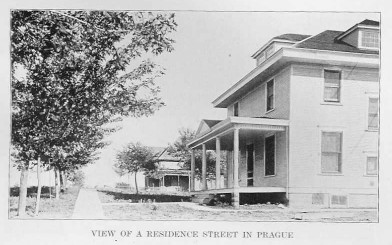
View of a Residence Street in Prague
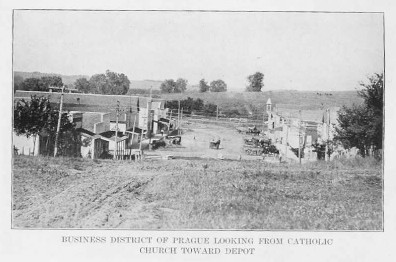
Business District of Prague looking from Catholic Church toward Depot
PAST AND PRESENT OF SAUNDERS COUNTY 125
colony of Swedes from Dalcadia. The Malmo settlement was originally the first Swedish settlement in the country with an organized church. This church was organized January 15, 1870. More detailed information concerning the Swedish settlements in Saunders County is written in the chapter on early settlement.
Gus Bredenburg, Charles Hulsing and Ed Bostrom constructed the first store in the village in 1887. This was a general store. The firm of Marsh & Chapman put up the second store. The first hotel was owned and operated by Fannie Baldwin.
The Farmers and Merchants Bank of Malmo was started in 1892 by W. H. Ostenburg as a private bank. On March 4, 1893, the bank was incorporated by the following men: W. H. Ostenburg (cashier), J. C, Frahm, R. B. Van Driel (president), C. J. Harrison, Peter Riemers, D. E. Bredenburg (vice president), John Frostrom, J. J. Johnson, C. W. Bruce, A. E. Larson, Edward Bostrom and P. B. Olson. The first capital stock was $25,000, the same as at present. The institution carries a surplus fund of $5,000 and the deposits average $200,000 on the year. Peter Riemers is the president in 1915; C. W. Bruce is vice president; Herman Lind is cashier; and W. H. and H. H. Ostenburg, J. C. Frahm, Christian Scow, M. S. Hills and Andrew Roslund are the directors. This bank has borne a steady reputation for splendid business methods and no bank in the county carries a greater amount of the dependency and faith of the people.
PRAGUE
The Town of Prague is located in section 36, Chester Precinct, and is reached by railroad on the Burlington, Schuyler branch. The town has become prosperous as a business center, being located advantageously for the farmers despite the relatively poor train service. The town is thirteen miles northwest of Wahoo. The town had its beginning with the completion of the Burlington road in the year 1888. At the very beginning the town did not grow very rapidly, but by the year 1896 the business section had taken on quite an important appearance. At this time there were: one bank, one drug store, one doctor, one hotel, one harness shop, one livery barn, one machine shop, one blacksmith, one well-boring outfit, one steam mill, one elevator,
126 PAST AND PRESENT OF SAUNDERS COUNTY
two furniture stores, two butcher shops, two hardware stores, two carpenter shops, two shoemakers, four saloons and four general stores. This compares very well with the present size of the town.
The Town of Prague was platted and surveyed in the year 1887. Among the first business houses of the town were Fisher & Simanek's elevator and lumber yard, Secor & Kasper's store for agricultural implements, hardware, stoves and tinware, M. Slamsidlo's blacksmith shop, and the hotel of Mrs. Mary Belek.
The Farmers and Merchants Bank of Prague was established in 1888 by W. C. Kirchman, F. J. Kirchman, Joseph Kasper, R. Safranek, and H. H. Dorsey. Since this time the institution has had a steady growth and now has a capital stock of $25,000, a surplus fund of $5,000, and undivided profits amounting to $10,000. The deposits average about $275,000 on the year. F. J. Kirchman is the president of the Farmers and Merchants Bank; W. C. Kirchman is the vice president; J. G. Hohl is the cashier; and J. E. Palensky is the assistant cashier.
The Bank of Prague is comparatively a new institution, but is a very popular one. This bank was established in 1906 with a paid up capital stock of $10,000, the same as at present. A building was constructed the same year as the organization, costing $2,500. The list of officers has not changed since the beginning, being as follows: E. E. Placek, president; Joseph Vlasak, vice president; J. J. Vlasak, cashier; A. L. Vlasak, assistant cashier. The Bank of Prague carries a surplus of $5,000 and the average yearly deposits amount to $200,000.
The town waterworks system of Prague was finished in February, 1907, by C. A. Killian of Morse Bluffs. The well is an 8-inch tubular one and 112 feet in depth, with 85-foot stand-pipe.
SWEDEBURG
In the spring of 1869 there arrived direct from Sweden thirty families, all of whom settled in the vicinity of the present Town of Swedeburg. Among them were: N. A. Aspengren, Nels Jonson, Truls Person, John and Magnus Erickson, John and Nels Gibson, Jons and Mons Martinson, Nets Eliason, Hans Hanson, Hans Hokanson and A. G. Quick. In the fall of the
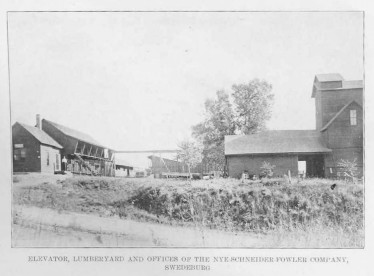
Elevator, Lumberyard and Offices of the Nye-Schneider-Fowler Company, Swedeburg
PAST AND PRESENT OF SAUNDERS COUNTY 127
same year 100 more families came. Some of these were the Petersons, Jeppsons, Carlsons, Swensons, Petersons, Olsons, Andersons, Goransons, Larsons, Wallins, Eliasons and Hokansons.
The Town of Swedeburg has since become an active trading point for the farmers in the vicinity, and, being located on the Chicago and Northwestern Railroad the shipping facilities are excellent.
The State Bank of Swedeburg was organized in 1907. J. J. Johnson is the president of this institution; Andrew Carlson is the vice president; and Frans Johnson is the cashier. The capital stock of the bank is $75,000; the surplus is $4,000; and the average yearly deposits is $80,000.
CERESCO
In July, 1868, E. and H. A. Andrews settled on Rock Creek on the southwest quarter of section 32, town 13, Richland Precinct, and at the close of the same season W. J. Gibbs and J. Nelson located on the west half of the same section. This settlement was called Ceresco. T. W. Riddle located on section 6 in 1870 and opened the first store in the town. Ceresco was first opened to a mail route in 1870 when the postal line was established between Fremont and this town, taking in Swedeburg, Wahoo and Cedar Bluff's also. T. W. Riddle was the first postmaster and kept the office at his store. This was the first mail route in the county. A. Andrus was another early storekeeper of Ceresco, also Ira Nelson.
The railroad was built through the town in 1886 and the site of Ceresco was officially surveyed on land bought of William Smith. In 1869, when the town was first started, it was located about one-half mile from the present site, on section 32. In 1886, as mentioned above, the coming of the railroad caused the town site to be moved to the present location. Ceresco was unfortunate in the year 1895, month of May, when a fire destroyed the main business portion. The business houses were rebuilt, however, and now Ceresco is one of the leading small towns of the county.
Substantial brick structures have largely replaced the old frame ones.
128 PAST AND PRESENT OF SAUNDERS COUNTY
The Farmers and Merchants Bank of Ceresco was organized on August 24, 1911, and the first officers were; J. L. Winter, president; H. E. Winter, secretary; and M. H. Gross, cashier. The first capital stock was $15,000. The present officers of this bank are: J. L. Winter, president; Alfred Peterson, vice president; William Breyer, vice president; and Fred Mostrom, cashier. The capital stock remains the same, $15,000; the surplus is now $1,000; and the deposits amount to $165,000.
The State Bank of Ceresco was organized in the year 1887 by N. H. Meeker of Greenwood. This is one of the oldest banks in the county and one of the most substantial. F. J. Maixmar is the president of the institution; Charles Maixmar is the cashier; and W. B. Thorpe is the assistant cashier. The capital stock is $10,000; the surplus, $5,000; and the deposits amount to $120,000. With the exception of one robbery, the State Bank of Ceresco has had an uninterrupted growth and, with the Farmers and Merchants Bank, well prove the financial condition of Ceresco and vicinity.
ITHACA
The first settler upon the site of the present Town of Ithaca was William Dech. He located on the northwest corner of section 20 in April, 1866, having just served in the Rebellion. His trip to this country was in search of health, following a physical breakdown resulting from a wound received in battle. Mr. Dech recovered his health and is still living at Ithaca, enjoying a comfortable old age. Mr. Dech's first home in Saunders County was part dugout and part log, the timber being cut from along the banks of the river at Ashland. This was the first home on the Wahoo Creek above Thompson Bissell's place. William Lucas, who located on section 20, came in the same year, 1866. Next came William Dech, Sr., Elijah Dech and William E. Dech. Fred Talcott from New York State located farther in the country from the Dech settlement and was the one to name the Town of Ithaca in honor of his home town, Ithaca, New York. The first postmaster in Ithaca was Elijah Dech and his daughter, Martha, taught the first school in a house which W. H. Dech had constructed on section 20. In 1868-69 Russell Roberts and

Public School, Ithaca
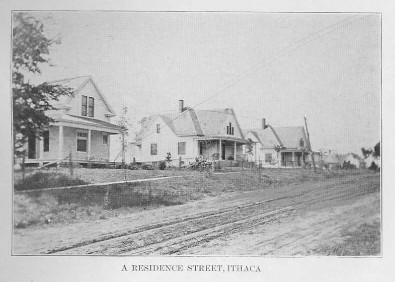
A Residence Street, Ithaca
PAST AND PRESENT OF SAUNDERS COUNTY 129
W. H. Dech built a home on the northwest corner of section 28 for Elijah Dech and this structure is still standing. The first store in the village was conducted by August Wagner; he carried a stock of general merchandise. In 1871 James Jardine and a Mr. Eberhart built a flouring mill, but sold out soon after to J. F. Roll and C. L. Meilenz.
The town was visited by a destructive fire on November 14, 1894, and the entire mercantile section was destroyed. The estimated loss amounted to fully $25,000. Ithaca has been built up again in better condition than previous to the fire.
The Farmers State Bank of Ithaca was organized in September, 1902. J. F. Wagner is the president; F. C. Hanke is the vice president; J. M. Hall the cashier; and Nora Walter the bookkeeper. The capital stock is $5,000; the surplus $8,000; and the deposits $120,000.
COLON
Located on the Chicago & Northwestern Railroad just north of Wahoo is the Town of Colon, a very small community, typical of the agricultural towns in Saunders County. Colon was platted in 1886 on land which the railroad bought from Martin Van Fleet. The Northwestern Road had just been constructed through the county and had established towns along its entire course. The postoffice at Colon was started in the same year, with E. O. Rand as the first postmaster. The town was incorporated December 1, 1894.
The State Bank of Colon was organized April 3, 1899, with these first officers: F. J. Kirckman, president; August Franson, vice president; J. W. Dailey, cashier. The first capital stock was $5,000. Now the capital has been increased to $20,000. The surplus fund is $2,700 and the deposits amount to about $150,000. J. J. Johnson and F. J. Kirchman are directors in this bank and J. F. Bastar is the cashier.
MORSE BLUFF
Morse Bluff is a small town, located west of Cedar Bluffs, on the David City branch of the Northwestern. The village was platted in 1887 on land originally owned by William Wheeler,
130 PAST AND PRESENT OF SAUNDERS COUNTY
and later transferred to C. L. Morse. The town was named after Mr. Morse. The Bank of Morse Bluff was organized in June, 1891, with the following officers: Jesse Gidley, president; Andrew Fleming, vice president; J. C. Hall, cashier. The present officers are: Walter Fleming, president; J. Q, Wilson, vice president; Emil E. Wolf, cashier; C. M. Skinner, assistant cashier. The capital stock of the institution is $30,000; the surplus $5,000; and the deposits $250,000.
Morse Bluff is distinctly an agricultural town. The growth has been retarded by the lack of train service, but even with this handicap has a very enduring structure. Morse Bluff has had a water system for five years and electricity for three years.
WESTON
John Bartek came to Nebraska in 1870 and took up a homestead, where he resided until 1880, then moved into Weston and started a store. He was a native of Bohemia, having been born in that country in 1832. Peter Campbell came to Nebraska in the fall of 1865, with his family, and located at Fort Kearney and started a ranch, which he ran until 1867, at which time the Indians paid a visit to his house and captured his four children, an account of which is given in the chapter on early settlement. In the spring of 1868 he settled in Chapman Precinct, being the first settler in that locality. He was born in Scotland in 1822. Joseph M. Chapman came to Nebraska in the fall of 1869 and homesteaded a place in section 4, Chapman Precinct. This precinct was named after him. He was a native of Pennsylvania. Robert A. Heaton, Jr., was a member of the firm of Clark, Heaton & Company, which firm was established at Weston in the spring of 1877, under the firm name of Dark & Son, Mr. Heaton becoming a partner in the fall of 1878. The firm erected the first elevator at Weston in November, 1880. Their shipment for the year 1881 was 400 cars of grain and in December of that year they shipped about 106 cars of grain and live stock. They received about seventy-five carloads of lumber at the Weston station every year. These figures are interesting in comparison to the present shipments from the Weston station on the Union Pacific. James Keay came to Nebraska in the fall of 1869 and first located in Butler County, where he took up a homestead and started a store.
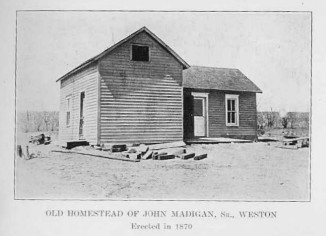
Old Homestead of John Madigan, Sr., Weston
Erected in 1870
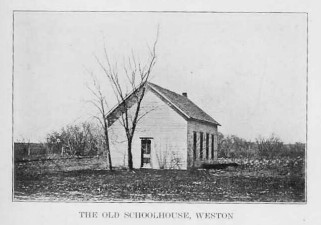
The Old Schoolhouse, Weston
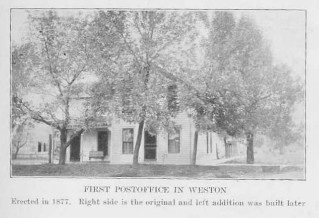
First Postoffice in Weston
Erected in 1877. Right side is the original and left addition was built later
PAST AND PRESENT OF SAUNDERS COUNTY 131
In the fall of 1877 he moved his goods to Weston and started the second general merchandise store at this place. He was born in Scotland in 1843. Henry C. Stevens came to Nebraska in 1872 and bought a farm three miles east of Wahoo, where he resided until 1879, then came into Weston and opened a blacksmith shop, which was the first in that town. Richard H. Thomas came to Nebraska in 1869 and took up a homestead two miles west of the present Town of Weston. In the summer of 1877 he moved into Weston and opened the first general merchandise store. He was born in Wales, March 10, 1848, and emigrated to the United States with his brother, John T., in 1868. John T. Thomas took up a claim with him at the same time in Saunders County.
Weston was platted in 1877 on land owned by Capt. William Davis and his son-in-law, William E. Hill. Largely through the efforts of Captain Davis the Union Pacific Railroad was induced to build their line through the town and to choose the site. This has been a wonderful impetus to the growth and prosperity of this small Bohemian town, a prosperity which is reflected in their fine church building, new schoolhouse, the two banks and the business houses and residences.
The Farmers and Merchants Bank of Weston was organized in 1906. W. C. Kirchman is the president of this institution; Karel Vlcan is the vice president; Ferdinand Pacal is the cashier. The bank carries a capital stock of $12,000 and a surplus of $2,000; while the average deposits on the year will amount to about $81,000.
The Weston Bank was one of the first in the county, having been organized in 1886. H. F. Blunk is the president; L. B. Bilan the vice president; Frank Koudele, cashier; and Frank Koudele, Jr., assistant cashier. The capital stock is $18,000; the surplus $10,000; and the deposits $250,000.
The fact that the total deposits in the two banks of Weston will total more than $325,000 proves the stability and thrift of the people.
TOUHY
The Village of Touhy is located almost midway between Weston and Valparaiso on the Union Pacific. The village was
132 PAST AND PRESENT OF SAUNDERS COUNTY
platted in 1892 on the farm of John H. Parker and named after a Mr. Touhy, former Union Pacific roadmaster. The railroad was responsible for the birth of this excellent little town and has been the means of sustaining it in a literal county of towns. The principal portion of the population is Bohemian in nationality.
The State Bank of Touhy was organized in 1906. J. Petermichel is the president; F. J. Kirchman the vice president; and J. J. Johnson, cashier. The capital stock is $50,000; the surplus $41,000; and the deposits $375,000. The State Bank has had unusual success considering the length of time since the organization.
MEMPHIS
The Village of Memphis is located on the Schuyler branch of the Burlington Route, between Wahoo and Ashland. The town had its beginning with the construction of this road and was located on land formerly owned by John C. Owens, but purchased by the Burlington. Memphis has never had a boom, but has maintained a consistent condition since the year of its start.
The Bank of Memphis was organized in 1902. R. K. Brown is the president of the institution; E. A. Wiggenhorn, vice president, and H. H. Ehlers, cashier. The capital stock is $5,000 at this time. The bank carries a surplus of $6,000 and the average yearly deposits amount to $60,000.
LESHARA
The Town of Leshara is the youngest in the county. The town was established by the Burlington Railroad and dedicated June 5, 1906. The Great Northern Railroad also aided in its establishment. Leshara is located on the site of an old Indian town, an account, of which is given in the earlier chapters of this book. The Nebraska State Historical Society took an active interest in the dedication of the town and had charge of the program. Speeches were made by Prof. A. E. Sheldon and E. E. Blackman and music was supplied by the university band. Lots in the new town were sold at auction.
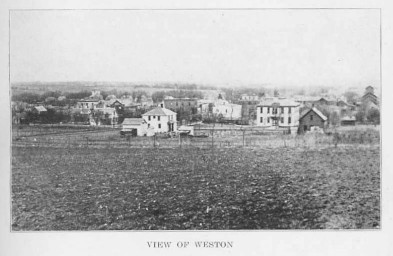
View of Weston
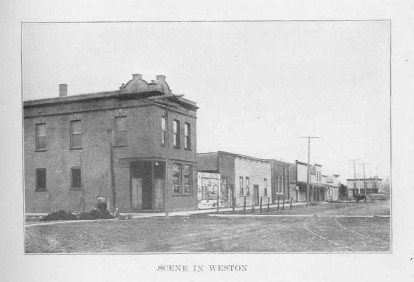
Scene in Weston
PAST AND PRESENT OF SAUNDERS COUNTY 133
The Leshara State Bank was established in the same year as the town. Jay Willey is the president of the bank; J. T. Conrad is the vice president; and T. F. Green the cashier. The capital stock is $10,000; surplus, $4,000; and deposits, $95,000.
Leshara has not had the opportunity to grow yet, but the people living there are of a type and disposition to push the town to the front among the others of Saunders County. Quite an amount of building is done every year.
|

